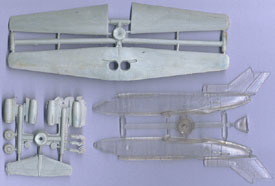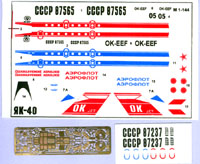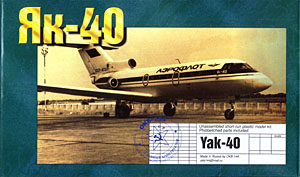OKB-144's 1/144
Yakovlev Yak-40 | | History Know how to tell the difference between Russian and Western aircraft? It’s quite simple, according to the instructions of this kit. Russian aircraft have larger wheels. In fact, the Yak-40 has mainwheels about the size of a Boeing 707. The reason? To quote the instructions, “nearly any aircraft specification issued in the USSR called for an aircraft to be operated from ‘{insert Russian text}’. What does it mean? ‘An unprepared runway’ to translate accurately, or ‘the whole ocean of mud’ to interpret faithfully.” This and other interesting tidbits are spread throughout the rather large instruction sheet (approximately a 2-foot square piece of paper, printed on both sides). In addition to the mainwheel bit, a rather comprehensive history of the Yak-40 is given, outlining it as a regional jet before regional jets came into vogue. On another part of the instructions (only 1/4 of the instruction sheet is actually related to building the model) is a short history of the Antonov-Beriev An-Be-20, which was the precursor of the Yak-40. Basically the whole idea of a plane of this type stemmed from the need to replace the old Li-2, Il-12 and Il-14 planes. Antonov and Beriev were approached, resulting in the mock-up of the An-Be-20, which was then worked into the Yak-40, which quickly proved popular with pilots and passengers alike. Aeroflot could now deliver passengers to locations where often roads and even rail did not go.  The Kit The Kit
The smooth lines of the Yak-40 are very well captured in this kit, although there is a bit of roughness around the edges. An interesting feature of this kit is that the fuselage is molded in clear plastic, eliminating any seams around the cabin windows. The cockpit window section is separate and is also molded in clear. There is a rough texture on the fuselage parts, so some light sanding will be in order. For the fastidious modeler you'll also want to drill out the center engine intake & exhaust. The wings are split into three pieces, with a one-piece lower section and upper wing halves. Like the fuselage, there is a texture to these parts, but it is heavier and will require more work to clean up, including rescribing some of the panel lines. The rest of the plastic parts make up the stabilizer, landing gear, and side engine nacelles. The details on these parts are basic but complete and after some slight cleanup they should look good.  What really helps this kit out is the nice fret of photo-etched brass. This fret includes extensive detail parts, both externally and internally. All the antennae on this plane are included, as well as the center engine thrust reversers, landing gear details, wheel well details, windscreen framing, and more. Be prepared for lots of folding and bending, but it will pay off greatly in the end. What really helps this kit out is the nice fret of photo-etched brass. This fret includes extensive detail parts, both externally and internally. All the antennae on this plane are included, as well as the center engine thrust reversers, landing gear details, wheel well details, windscreen framing, and more. Be prepared for lots of folding and bending, but it will pay off greatly in the end.
There are three choices on the decal sheet, one Aeroflot scheme, one VVS scheme, and one Czech Airlines scheme. The three schemes are similar in coloring, with a white upper fuselage and gray lower fuselage & wings. On the Aeroflot & VVS planes the upper half of the engine nacelles is painted in Aeroflot blue, matching the cheatline. The decals look to be decently printed, although the blue and red seem a bit bright. Conclusion This is a welcome kit of a plane we're not likely to see from any other injection manufacturer. While it may take a bit more work to finish, it looks to be quite accurate and will really look neat sitting in any 1/144 collection. Listed on the box is a Tu-104 and if it's anything like this kit it too should be a good kit. OKB-144 kits are available from Skyway Hobby Shop. Skyway has some of the best customer service I've ever come across and you should definitely try them out. | 


 




    |
